Key Scottish Environment Statistics 2016
Reference document offering information on a wide range of environmental topics, covering key datasets.
This document is part of a collection
Biodiversity
Background
Biodiversity is the variety of life on Earth. It is the variety within and between all species of plants, animals and microorganisms and the ecosystems in which they live and interact. Although biodiversity is difficult to measure directly, it is estimated that there are around 90,000 species in Scotland.
Importance of biodiversity
Biodiversity is directly related to the provision of environmental services, where a healthy environment provides direct and indirect benefits, such as pollination by insects and carbon sinks from woodland. Scottish Natural Heritage estimates that biodiversity brings a value of almost £17.2 billion to the Scottish Economy [132] . Aspects of biodiversity are also culturally important, with certain iconic species being seen as defining the environment in Scotland, such as red squirrels and capercaillies.
Threats
Biodiversity is threatened by a wide range of factors: development, climate change, habitat destruction, pollution, changing land management and invasive non-native species. In many cases, these are measured in earlier chapters of Key Scottish Environment Statistics, providing an indication of progress.
Proxy indicators
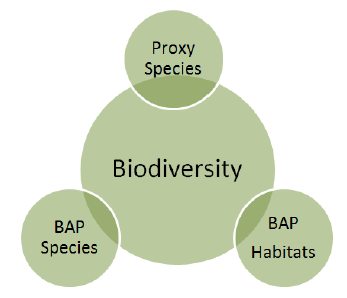
Directly measuring biodiversity would involve taking inventory of all species in an environment, which would be an impractical task. As a result, biodiversity is instead measured by the use of proxy indicators. These are more easily measured traits that are reflective of the overall state of biodiversity.
In addition, efforts are made to directly record priority species that are covered by Biodiversity Action Plans, which form a framework for the conservation of the UK's most at risk species.
Targets and Objectives
- Scottish Biodiversity Strategy aims to conserve biodiversity [133]
- Scotland Performs National Indicator: Increase the abundance of terrestrial breeding birds [134] , which is used as a proxy measure of biodiversity.
Status of UK Biodiversity Action Plan ( BAP) Habitats in Scotland: 2008
Status of UK BAP Habitats (based on 39 UK BAP priority habitats in Scotland)
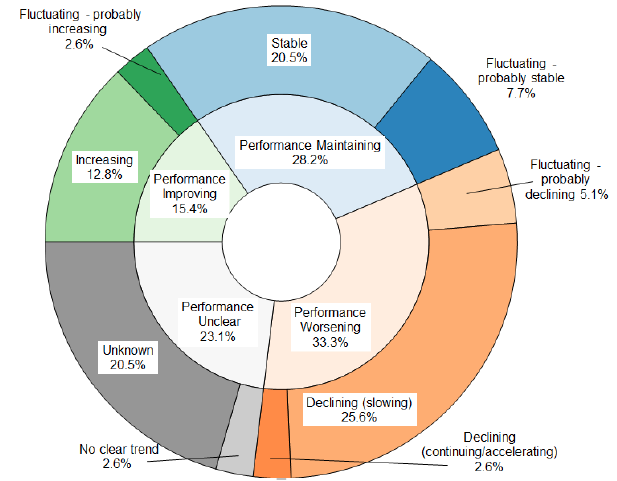
Why this measure is important
Biodiversity refers to the variety of plant and animal life. The conservation and enhancement of our rich and varied natural heritage of plants and animals, habitats and ecosystems, is essential to the quality of our lives and for a sustainable future.
Background
In 1992, the UN Convention on Biological Diversity recognised the need to protect biodiversity. The UK was one of the 150 countries to sign up to the convention, and in 1994, the UK Biodiversity Action Plan ( UK BAP) was launched. The plan aims to conserve and enhance the populations of species and habitats that are considered to be threatened within the UK.
Trend
Between 1995 and 1999, action plans were developed for 45 priority habitats in the UK [135] , of which 39 occur in Scotland. As at 2008, of these 39, 15% of the habitats were increasing, 28% were considered stable and 33% were in decline. For the remainder, 23% had an unknown trend and for one habitat, the trend was unclear.
Factors affecting trend
Changes are often associated with land management and atmospheric pollution, although the effects of climate change may become evident in the future.
Source: Biodiversity Action Reporting System ( BARS)
Metadata
Status of UK Biodiversity Action Plan ( BAP) Species in Scotland: 2008
Status of UK BAP Species [136] (based on 197 UK BAP priority species)
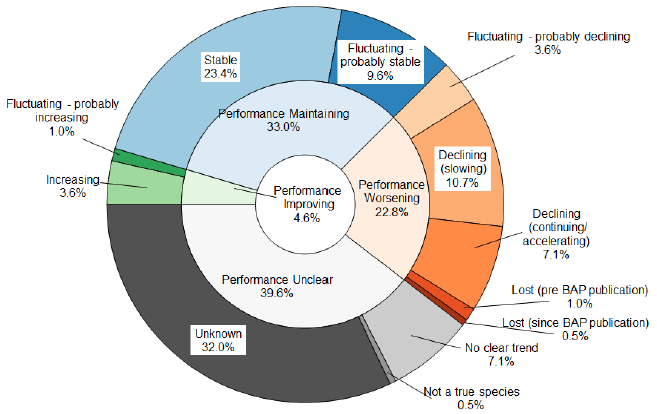
Why this measure is important
In 1994, the UK Biodiversity Action Plan ( BAP) was launched. The action plan aims to conserve and enhance the populations of species and habitats that are considered threatened in the UK.
Background
The Scottish Biodiversity Strategy, first published in 2004, sets out how Scotland plans to protect biodiversity in Scotland. Following the agreement of new targets under the UN's Convention on Biological Diversity in 2010 and the publication of a European Biodiversity Strategy, the Scottish Biodiversity Strategy was refreshed in 2013. Following the publication of the refreshed strategy a revised Scottish Biodiversity List was produced. A formal assessment of the status of these species has not yet been undertaken. Between 1995 and 1999, action plans were developed for 391 species in the UK that had been identified as priorities. 197 of these occur in Scotland.
Trend
In the 2008 assessment for Scotland, 38% of the priority species were increasing or stable and 21% were in decline. For the remainder of the species considered, 7% showed no clear trend, 32% had an unknown trend, one species (Wryneck) had been lost since the commencement of BAP in 1994, 2 had been lost pre BAP and 1 (scurvy grass) was no longer considered a true species.
Factors affecting trend
Changes are often associated with invasive species and land use patterns.
Source: Biodiversity Action Reporting System ( BARS )
Metadata
Status of Wild Bird Populations: 1975-2014 R [137]
Index (1994 = 100)
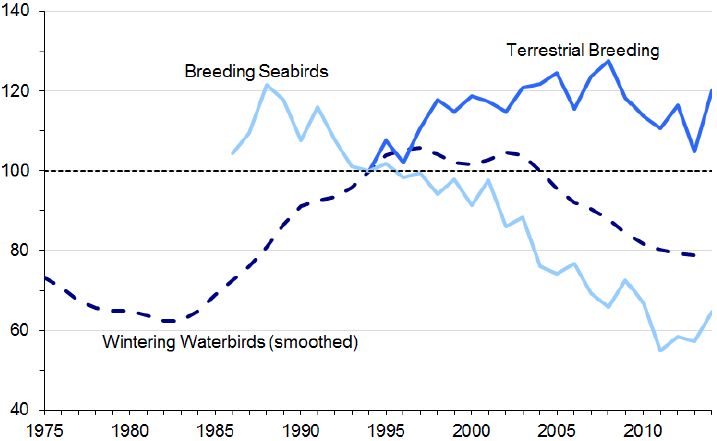
Why this measure is important
Bird populations are diverse and easy to monitor. They are sensitive to changes in the wider environment and therefore can provide an indication of the state of biodiversity in Scotland's habitats.
Background
Data are obtained from the British Trust for Ornithology ( BTO) Breeding Bird Survey [138] , the JNCC Seabird Monitoring Programme [139] and the Wetland Bird Survey [140] . The Breeding Bird Survey and Wetland Bird Survey are both volunteer surveys run by the BTO.
Trend
The number of wintering waterbirds rose between the mid-1980s and mid-1990s, reaching a peak in 1997. Since then there has been a steady decline, with the abundance falling 26% between 1997 and 2013. The abundance of breeding seabirds has declined by 44% between 1991 and 2014. The abundance of terrestrial breeding birds has shown a long-term increase of 20.1% between 1994 and 2014. In the last year, the abundance of terrestrial breeding birds increased by 14.6%, following a general decline from the peak of 2008.
Factors affecting trend
The status of wild bird populations can vary greatly from year to year. The abundance of birds may be affected by many factors such as the weather, changes to habitats and changes in the abundance of food sources.
Source: British Trust for Ornithology / Joint Nature Conservation Committee / Wildfowl and Wetlands Trust
Metadata
Selected Commercial Fish Stocks: 1960-2016 P, R [141,142]
Spawning Stock Biomass ( SSB) [143] (thousand tonnes)
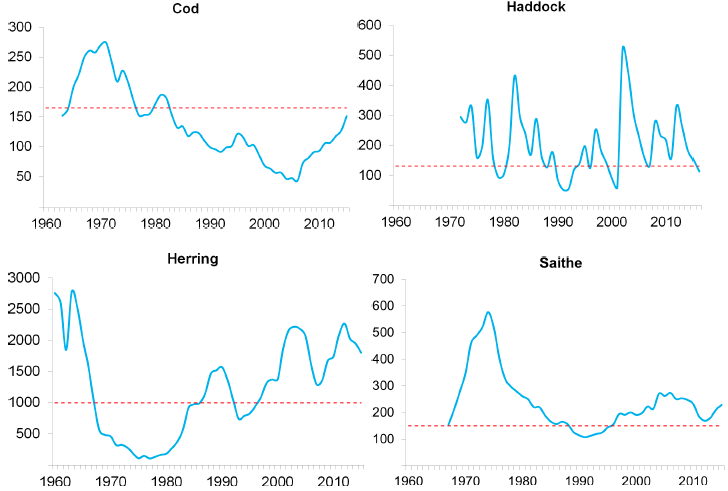
precautionary biological limit (Bpa)
Why this measure is important
If fish stocks are in a poor state it can have a knock-on effect on other parts of the marine ecosystem. The state of commercial fish stocks may be considered, alongside other indicators, as a proxy for the general sustainability of the marine environment.
Background
One measure of the state of a fish stock is the size of its spawning stock biomass ( SSB). The health of the fish stock can then be indicated by comparing the SSB with a precautionary value, or reference point (Bpa). [144] Data for haddock are provisional [145] .
Trend
The SSB of North Sea cod has increased each year since historical lows in 2006, although the value of 161 kt in 2016 is still just below the Bpa of 165 kt. The SSB of herring stocks has been above the Bpa of 1,000 kt since 1997 and was recorded as 2,008 kt in 2016. The SSB of the North Sea/West of Scotland saithe saw a 20-year decline in SSB levels between 1970s - 1990s. Since then, the SSB of saithe has increased above the Bpa of 150 kt and was recorded as 240 kt in 2016. Provisional data shows that the SSB of haddock has been above the Bpa of 132 kt since 2002, but is expected to fall below the Bpa in 2016, at 114 kt.
Factors affecting trend
The size of these fish stocks are affected by several factors, including commercial fishing and other factors such as climate change and success of recruitment (the number of young fish entering the adult population each year).
Source: Marine Scotland Science / ICES
Metadata
Catches of Wild Salmon: 1952-2015 [147]
Number caught (thousands) [148,149]
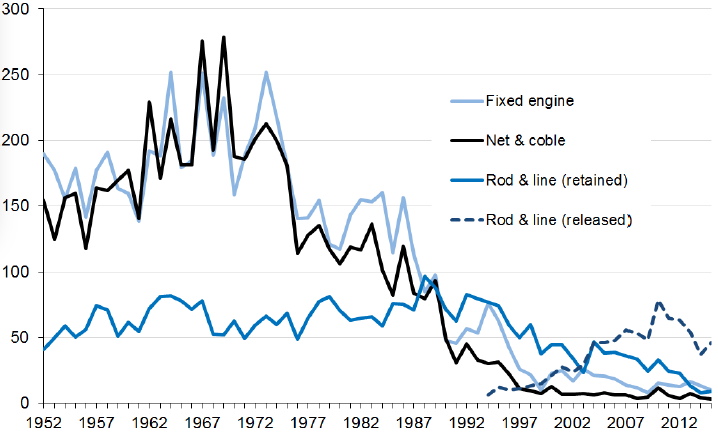
Why this measure is important
The salmon fishing industry is a significant economic and leisure resource in rural Scotland and so protecting this resource through sustainable management practices is of great importance. Climate change, water pollution, predation and disease may affect populations.
Background
Data are obtained from Marine Scotland and are based on returns from proprietors, occupiers or agents of salmon fisheries throughout Scotland.
Trend
The total reported rod catch (both retained and caught and released) of wild salmon and grilse for 2015 is 54,969. While total reported catch has increased over the return for 2014, it is still nevertheless 69% of the previous 5-year average. The number of salmon caught and released increased from 6,595 in 1994 to 45,973 in 2015. In 2015, 84% of the annual rod catch was released compared to less than 8% in 1994.
Catch sizes for the fixed engine and net & coble fisheries have fallen by over 90% since 1952. Catches rose during the 1950s and 1960s but have declined rapidly since the early 1970s. In 2015, 10,349 wild salmon were reported caught and retained in the fixed engine fishery and 3,234 in the net and coble fishery. [150]
Factors affecting trend
Yearly variations in weather, timing of runs and fishing effort can affect catch sizes; and so a difference in catch does not necessarily indicate a difference in the abundance of the stock that provides the catch. In addition, a proportion of fish released from the rod fishery may be re-caught and so inflate the catch statistics by being reported more than once.
Source: Marine Scotland Science
Metadata
Contact
There is a problem
Thanks for your feedback